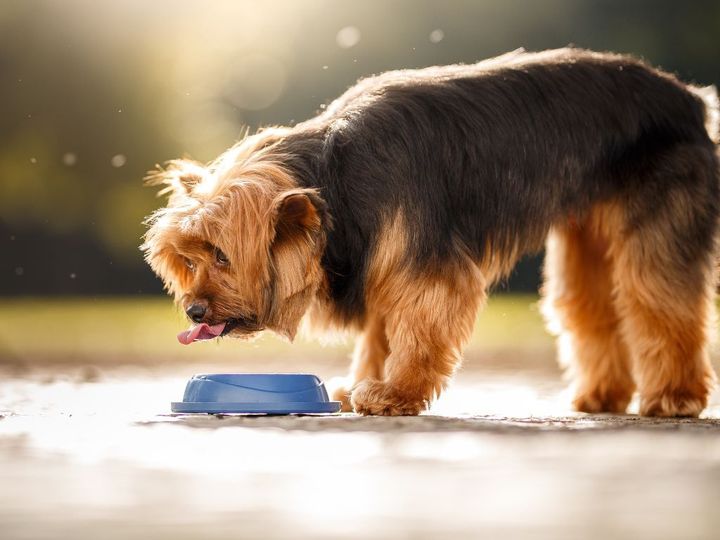Dog Ate Drywall: What Will Happen & What to Do ASAP

Dogs, like many other animals, are naturally curious and may be drawn to investigate and taste various objects in their environment. It can be said that eating non-food items like grass that are not toxic is natural habit for dogs.
However, dogs can unfortunately ingest weird objects like tennis balls, tea bags, or candles that could hurt them if immediate action is not taken.
Why would my dog eat drywall? 🤦
Your dog would eat drywall for a number of reasons, like hunger, boredom, or because of a mineral deficiency in its diet.
There are cases where dogs might eat non-food items as a sign of a medical condition called pica. That's why is important to talk with a vet to exclude any underlying medical conditions and to decide the best course of action.
Meanwhile, it's crucial to keep your dog away from any drywall or other non-food objects while also giving it suitable chew toys and other enrichment activities.
What will happen if a dog eats drywall? Will drywall hurt my dog?
It could be harmful to a dog's health to eat drywall. Gypsum, a soft sulfate mineral comprised of calcium sulfate dihydrate, is used to make drywall. Eating drywall may result in digestive issues like nausea, vomiting, and diarrhea. Large amounts of drywall in the stomach can result in more severe problems such as gastrointestinal obstructions, which can be fatal if left untreated.
☠️ How poisonous is drywall? Side Effects
Although eating drywall is not thought to be very toxic to dogs, it can nevertheless have negative health effects. The risk of digestive problems like upset stomach, vomiting, and diarrhea when dogs consume drywall is the biggest worry. Gypsum can also irritate the stomach and intestines, resulting in inflammation and bleeding.
Due to the presence of dangerous compounds like formaldehyde and sulfur, eating drywall can also be harmful to a dog's health. As side effects, these substances can harm your dog's skin, create breathing troubles, and other health problems.
In addition, consuming drywall dust can irritate the eyes, nose, and throat and result in coughing, breathing difficulties, and other respiratory issues.
It's essential to remember that each dog is unique and may respond to drywall intake in a different way. It's imperative to get in touch with your vet right away for a diagnosis if you believe your dog has consumed drywall. Doctors may perform certain tests to look for underlying health conditions and can advise you on the appropriate course of treatment.
🔴 First step to take: Get in touch with your vet
Call your veterinarian as soon as you suspect your dog has consumed drywall. To find out if your dog has consumed any drywall and to look for any other health issues, they can do a physical examination, take x-rays, or perform blood testing. They will also provide you with treatment recommendations and, if required, suggest that you hospitalize your dog to ensure that they receive the right care.
How do you fix a dog that ate drywall?
🤮 Inducing vomiting: In order to get rid of as much drywall from your dog's stomach as possible if it recently ate it, your veterinarian may make your dog vomit.
🧪 Gastrointestinal decontamination: In order to assist absorb any remaining drywall in your dog's stomach, your vet may administer activated charcoal.
🥼 Surgery: To remove drywall that has become caught in the digestive system, surgery may be required.
💊 Medications: If your dog has eaten drywall, your vet may recommend drugs to address any symptoms or side effects.
Your veterinarian may also suggest supportive care in addition to the aforementioned, such as water and medication to reduce inflammation in the stomach and intestines.
How to stop dog from eating drywall
- Give your dog enough suitable chew toys: Dogs who are bored or who have a strong want to chew may be more prone to consume drywall, so make sure you have lots of suitable chew toys available. Giving your dog a lot of suitable chew toys might help keep them engaged and reduce their need to chew on anything other than food.
- Increase exercise and playtime: Regular fun and exercise will help your dog become tired and less energetic, which can lower the chance that it will chew everything in its way.
- Address underlying health issues: If your dog has a condition like pica, which leads them to consume objects other than food, it's imperative to address the underlying condition. Your vet can help you identify the actual reason of your dog's behavior and recommend the best course of action.
- Maintain a secure environment for your dog: Make sure that any drywall or other non-food things are out of the dog's reach. This can entail locking any doors or gates leading to rooms with drywall and making sure that any holes in the walls or flooring are securely sealed.
- Ensure your dog has a balanced diet: Begin giving your dog the nutrients it needs to stay healthy. This can help prevent nutritional deficits that might cause your dog to crave non-food items.
- Regular vet check-ups: Regular examinations by your vet can help determine any latent health conditions that might be influencing your dog's behavior and guarantee that your dog is generally in good health.
It's crucial to keep in mind that every dog is unique and may need for a different strategy to keep them from chewing drywall. To create a strategy that is effective for your dog, speak with your vet.




Comments ()